Research on the Risk Factors and Promotion Strategies of BIM Application in China
Abstract
1. Introduction
- What are the main risk factors associated with BIM application in China’s construction industry?
- What are the interrelationships among these risk factors?
- How can these risk factors be evaluated and addressed?
2. Related Work
2.1. Overview of Building Information Modeling
2.2. BIM Risk-Related Research
3. Methodology
3.1. Initial List of Risk Factors of BIM Application
3.2. Analytic Hierarchy Process—AHP
- (1)
- Decompose the research problem
- (2)
- Design a questionnaire
- (3)
- Weight Calculation
- (4)
- Consistency Check
- (5)
- Calculation of Actual Weights for Indicator Layer
3.3. Interpretative Structural Modeling-ISM
- (1)
- Determination of system elements Si. The identification of system elements is based on the specific objectives of the study. In this research, the system elements are the major risk factors of BIM application selected through AHP analysis.
- (2)
- Establish an adjacency matrix A. Semi-structured interviews were conducted with experts to evaluate direct relationships between factors. After consolidating expert opinions, adjacency matrix A was constructed, where element aij equals 0 or 1; 0 indicates no direct relationship between two factors, and 1 indicates a direct relationship exists.Note: aij = 0, there is no direct relationship between factor Si and factor Sj. aij = 1, there is a direct relationship between factor Si and factor Sj.
- (3)
- Calculate the reachability matrix. The reachability matrix indicates the extent to which system elements can reach each other through paths of certain lengths. Reachability matrix R is obtained by performing Boolean algebra operations on the adjacency matrix A plus the identity matrix I.
- (4)
- Regional Division: Firstly, determine the reachable set, antecedent set, and the intersection of the reachable set (R(Si)) and antecedent set (A(Si)) for each risk factor based on the reachability matrix. Then, use Equation (9) to identify the set of fundamental risk factors. The system’s coherence is determined by whether the intersection of reachable sets of fundamental factors is empty. If the intersection of reachable sets of fundamental factors is not empty, then all system factors are within the same connected domain.
- (5)
- Level partitions. Based on the reachability matrix, categorize all risk factors in the system into different levels using the definition of maximum sets. Specifically:Here, Lk represents the level of risk factors, N represents the set of risk factors, R(Si) denotes the reachable set of risk factor Si, and A(Si) represents the antecedent set of risk factor Si.
- (6)
- Establishing a Hierarchical Structure Model: Based on the hierarchical division results, a reduced reachable matrix R’ is constructed. After sorting, the reduced reachable matrix becomes a lower triangular matrix. Each constraining factor is plotted according to its level. The relationships between adjacent factors are represented by directed line segments, and if there are directed line segments between adjacent levels, there is no need to plot connections between factors across levels.
3.4. Matrices Impacts Corises-Multiplication Appliance Classification—MICMAC
3.5. Data Collection
4. Results and Analysis
4.1. Determining Key Risk Factors for BIM Application Based on AHP
4.2. Determining Interrelationships Among Key Risk Factors Based on ISM
4.3. Classification Analysis of Risk Factors Based on MICMAC
5. Discussion and Recommendations
5.1. Discussion
5.2. Related Response Strategies to the Risk Factors of BIM Implementation
6. Conclusions
- (1)
- Through literature review, an initial list of BIM implementation risk factors was established, identifying 31 risk factors across five dimensions: technical, economic, legal, managerial, and procedural. To extract the primary risk factors, questionnaires were distributed to score the relative importance of each factor using a 9-point scale. The AHP method ultimately identified 24 major BIM application risk factors, among which “Uncertainty in return on investment” carried the highest weight.
- (2)
- Building on the identification of key BIM application risks, the ISM method was applied to analyze interrelationships among risk factors, categorizing them into seven hierarchical levels. MICMAC analysis further classified the risk factors into 10 autonomous factors, 10 driving factors, and 4 dependent factors. The study reveals that “inadequate BIM standards and protocols (L1),” along with “lack of software function (T1),” “Inadequate BIM-related laws and regulations (L2),” “Infrastructure preparation of BIM application (E2),” “Lack of BIM practical experience (M1),” and “Changes in delivery mode (P7),” constitute the root causes of BIM application challenges. Meanwhile, “Uncertainty in return on investment (E4)” and “Synergy-dilemma (M3)” are top-level factors in the model, representing the most direct causes of BIM-related risks.
- (3)
- Based on risk classification, a three-tiered strategy to promote BIM implementation was proposed across industry, organizational, and project levels. At the industry level, academia, government, and software vendors should focus on addressing foundational factors. At the organizational level, enterprises and individuals should prioritize organizational restructuring and skill development. At the project level, BIM-based project management should be implemented in alignment with specific project objectives.
Author Contributions
Funding
Data Availability Statement
Acknowledgments
Conflicts of Interest
References
- Rezgui, Y.; Zarli, A. Paving the way to the vision of digital construction: A strategic roadmap. J. Constr. Eng. Manag. 2006, 132, 767–776. [Google Scholar] [CrossRef]
- Li, S.; Jiang, Z.; Xu, Z. BIM-Based Model Checking: A Scientometric Analysis and Critical Review. Appl. Sci. 2025, 15, 49. [Google Scholar] [CrossRef]
- Giel, B.K.; Issa, R.R.A. Return on Investment Analysis of Using Building Information Modeling in Construction. J. Comput. Civ. Eng. 2013, 27, 511–521. [Google Scholar] [CrossRef]
- Heaton, J.; Parlikad, A.K.; Schooling, J. A Building Information Modelling approach to the alignment of organisational objectives to Asset Information Requirements. Autom. Constr. 2019, 104, 14–26. [Google Scholar] [CrossRef]
- Charef, R.; Emmitt, S. Uses of building information modelling for overcoming barriers to a circular economy. J. Clean. Prod. 2021, 285, 124854. [Google Scholar] [CrossRef]
- Lee, D.-J.; Hyun, J.-O.; Min, S.G.; Lim, J.-Y.; Shin, M.C.; Kwon, S.H. A Case Study on Construction Management Based on BIM Data. KSCE J. Civ. Environ. Eng. Res. 2024, 44, 223–229. [Google Scholar]
- BS EN ISO 19650; Organization and Digitization of Information about Buildings and Civil Engineering Works, Including Building Information Modelling (BIM)—Information Management Using Building Information Modelling. British Standards Institution: London, UK, 2019.
- Abanda, F.H.; Balu, B.; Adukpo, S.E.; Akintola, A. Decoding ISO 19650 Through Process Modelling for Information Management and Stakeholder Communication in BIM. Buildings 2025, 15, 431. [Google Scholar] [CrossRef]
- Hwang, B.G.; Ngo, J.; Her, P.W.Y. Integrated Digital Delivery: Implementation status and project performance in the Singapore construction industry. J. Clean. Prod. 2020, 262, 121396. [Google Scholar] [CrossRef]
- Liao, L.; Teo, E.A.L. Critical Success Factors for enhancing the Building Information Modelling implementation in building projects in Singapore. J. Civ. Eng. Manag. 2017, 23, 1029–1044. [Google Scholar] [CrossRef]
- Waqar, A.; Othman, I.; Radu, D.; Ali, Z.; Almujibah, H.; Hadzima-Nyarko, M.; Khan, M.B. Modeling the Relation between Building Information Modeling and the Success of Construction Projects: A Structural-Equation-Modeling Approach. Appl. Sci. 2023, 13, 9018. [Google Scholar] [CrossRef]
- Chen, Y.; Dib, H.; Cox, R.F.; Shaurette, M.; Vorvoreanu, M. Structural Equation Model of Building Information Modeling Maturity. J. Constr. Eng. Manag. 2016, 142, 04016032. [Google Scholar] [CrossRef]
- Altwassi, E.J.; Aysu, E.; Ercoskun, K.; Abu Raed, A. From Design to Management: Exploring BIM’s Role across Project Lifecycles, Dimensions, Data, and Uses, with Emphasis on Facility Management. Buildings 2024, 14, 611. [Google Scholar] [CrossRef]
- Cao, P.; Cao, Z.; Huang, D.L.; Wang, J.W. Hybrid Model for BIM Application Maturity in Prefabricated Buildings: A Case Study in Xi’an, China. Buildings 2025, 15, 1322. [Google Scholar] [CrossRef]
- Xiang, Y.M.; Mahamadu, A.M.; Florez-Perez, L. Engineering information format utilisation across building design stages: An exploration of BIM applicability in China. J. Build. Eng. 2024, 95, 110030. [Google Scholar] [CrossRef]
- Xie, M.J.; Qiu, Y.; Liang, Y.; Zhou, Y.; Liu, Z.; Zhang, G. Policies, applications, barriers and future trends of building information modeling technology for building sustainability and informatization in China. Energy Rep. 2022, 8, 7107–7126. [Google Scholar] [CrossRef]
- Ozorhon, B.; Karahan, U. Critical Success Factors of Building Information Modeling Implementation. J. Manag. Eng. 2017, 33, 04016054. [Google Scholar] [CrossRef]
- Kuai, X.; Liu, Y.; Bi, M.; Luo, Q. Deciphering Building Information Modeling Evolution: A Comprehensive Scientometric Analysis across Lifecycle Stages. Buildings 2023, 13, 2688. [Google Scholar] [CrossRef]
- Viana, V.L.B.; Carvalho, M.T.M. Prioritization of Risks related to BIM Implementation in Brazilian Public Agencies Using Fuzzy Logic. J. Build. Eng. 2020, 36, 102104. [Google Scholar] [CrossRef]
- Farooq, U.; Rehman, S.K.U.; Rehman, U.; Faisal, A.; Alyousef, R. Investigating BIM Implementation Barriers and Issues in Pakistan Using ISM Approach. Appl. Sci. 2020, 10, 7250. [Google Scholar] [CrossRef]
- ISO 31000; Risk Management—Guidelines. International Organization for Standardization: Geneva, Switzerland, 2009.
- Sun, C.; Jiang, S.; Skibniewski, M.J.; Man, Q.; Shen, L. A literature review of the factors limiting the application of BIM in the construction industry. Technol. Econ. Dev. Econ. 2015, 23, 764–779. [Google Scholar] [CrossRef]
- Sun, C.; Xu, H.; Jiang, S. Understanding the risk factors of BIM technology implementation in the construction industry: An interpretive structural modeling (ISM) approach. Eng. Constr. Archit. Manag. 2020, 27, 3289–3308. [Google Scholar] [CrossRef]
- Liang, R.B.; Ma, H.B.; Wang, P.; Zhao, L. The applications of building information modeling in the life-cycle of green buildings: A comprehensive review. Sci. Technol. Built Environ. 2024, 30, 932–958. [Google Scholar] [CrossRef]
- Meng, G.; Hu, H.; Chen, L. The application obstacles of BIM technology in green building project and its key role path analysis. Sci. Rep. 2024, 14, 30330. [Google Scholar] [CrossRef]
- Chien, K.F.; Wu, Z.H.; Huang, S.C. Identifying and assessing critical risk factors for BIM projects: Empirical study. Autom. Constr. 2014, 45, 1–15. [Google Scholar] [CrossRef]
- Hsu, K.M.; Hsieh, T.Y.; Chen, J.H. Legal risks incurred under the application of BIM in Taiwan. Proc. Inst. Civ. Eng. 2015, 168, 127–133. [Google Scholar] [CrossRef]
- Tan, T.; Chen, K.; Xue, F.; Lu, W. Barriers to Building Information Modeling (BIM) implementation in China’s prefabricated construction: An interpretive structural modeling (ISM) approach. J. Clean. Prod. 2019, 219, 949–959. [Google Scholar] [CrossRef]
- Tabatabaee, S.; Mahdiyar, A.; Ismail, S. Towards the success of Building Information Modelling implementation: A fuzzy-based MCDM risk assessment tool. J. Build. Eng. 2021, 43, 103117. [Google Scholar] [CrossRef]
- Zarghami, S.A. Anatomy of interactions among risk factors influencing implementation of building information modeling (BIM): A system dynamics approach. Eng. Constr. Archit. Manag. 2023, 30, 1527–1541. [Google Scholar] [CrossRef]
- Chan, D.W.M.; Olawumi, T.O.; Ho, A.M.L. Perceived benefits of and barriers to Building Information Modelling (BIM) implementation in construction: The case of Hong Kong. J. Build. Eng. 2019, 25, 100764. [Google Scholar] [CrossRef]
- Wu, Z.; Lu, Y.; He, Q.; Hong, Q.; Chen, C.; Antwi-Afari, M.F. Investigating the Key Hindering Factors and Mechanism of BIM Applications Based on Social Network Analysis. Buildings 2022, 12, 1270. [Google Scholar] [CrossRef]
- Liu, Y.; Van Nederveen, S.; Hertogh, M. Understanding effects of BIM on collaborative design and construction: An empirical study in China. Int. J. Proj. Manag. 2017, 35, 686–698. [Google Scholar] [CrossRef]
- Fan, H.Y.; Miroslaw, J. A Critical Review of Legal Issues and Solutions Associated With Building Information Modelling. Technol. Econ. Dev. Econ. 2018, 24, 2098–2130. [Google Scholar] [CrossRef]
- Almarri, K.; Aljarman, M.; Boussabaine, H. Emerging contractual and legal risks from the application of building information modelling. Eng. Constr. Archit. Manag. 2019, 26, 2307–2325. [Google Scholar] [CrossRef]
- Mahdian, A.; Jalal, M.P.; Roushan, T.Y. Contractual Risks of BIM Implementation and the Proposed Contract Form for DBB and DB Projects. J. Leg. Aff. Disput. Resolut. Eng. Constr. 2023, 15, 06522003. [Google Scholar] [CrossRef]
- Ghaffarianhoseini, A.; Tookey, J.; Ghaffarianhoseini, A.; Naismith, N.; Raahemifar, K. Building Information Modelling (BIM) uptake: Clear benefits, understanding its implementation, risks and challenges. Renew. Sustain. Energy Rev. 2016, 75, 1046. [Google Scholar] [CrossRef]
- Jin, R.Y.; Hancock, C.M.; Tang, L.; Wanatowski, D. BIM Investment, Returns, and Risks in China’s AEC Industries. J. Constr. Eng. Manag. 2017, 143, 04017089. [Google Scholar] [CrossRef]
- Seyis, S. Pros and cons of using building information modeling in the aec industry. J. Constr. Eng. Manag. 2019, 145, 04019046. [Google Scholar] [CrossRef]
- Zhao, X.B.; Wu, P.; Wang, X.Y. Risk paths in BIM adoption: Empirical study of China. Eng. Constr. Archit. Manag. 2018, 25, 1170–1187. [Google Scholar] [CrossRef]
- Huang, B.; Lei, J.; Ren, F.; Chen, Y.; Zhao, Q.; Li, S.; Lin, Y. Contribution and obstacle analysis of applying BIM in promoting green buildings. J. Clean. Prod. 2021, 278, 123946. [Google Scholar] [CrossRef]
- Bian, J.; Wang, Z.; Liu, X. Research on Restrictive Factors of Assembly Building Development based on Principal Components Analysis Method. Constr. Econ. Build. 2021, 42, 76–80. [Google Scholar]
- Wang, T.; Wang, X.T.; Wang, L.; Cheong, P.A.Y.; Ali, A.S. Assessment of the development level of regional industrialized building based on cloud model: A case study in Guangzhou, China. J. Build. Eng. 2021, 44, 102547. [Google Scholar] [CrossRef]
- Durdyev, S.; Ashour, M.; Connelly, S.; Mahdiyar, A. Barriers to the implementation of Building Information Modelling (BIM) for facility management. J. Build. Eng. 2022, 46, 103736. [Google Scholar] [CrossRef]
- Lee, S. Determination of priority weights under multiattribute decision-making situations: Ahp versus fuzzy ahp. J. Constr. Eng. Manag. 2015, 141, 05014015. [Google Scholar] [CrossRef]
- Wang, Q.; Shen, C.; Guo, Z.; Zhu, K.; Zhang, J.; Huang, M. Research on the Barriers and Strategies to Promote Prefabricated Buildings in China. Buildings 2023, 13, 1200. [Google Scholar] [CrossRef]
- Thomas, D.; Khanduja, D. ISM–ANP hybrid approach to prioritize the barriers in green lean Six Sigma implementation in construction sector. Int. J. Lean Six Sigma 2022, 13, 502–520. [Google Scholar] [CrossRef]
- Suermann, P.C.; Issa, R.R.A. Evaluating Industry Perceptions of Building Information Modeling (BIM) Impact on Construction. Electron. J. Inf. Technol. Constr. 2009, 14, 250–256. [Google Scholar]
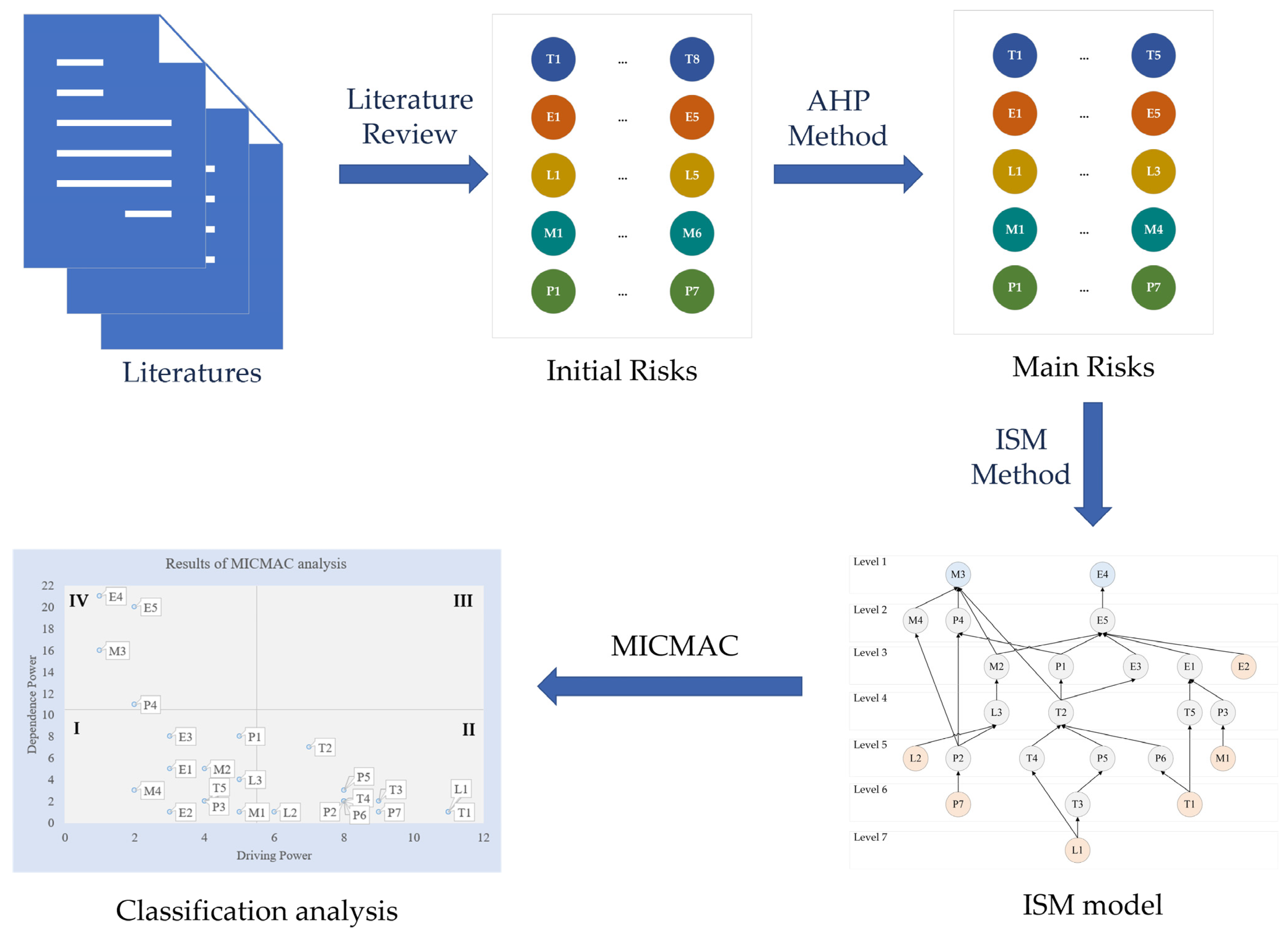
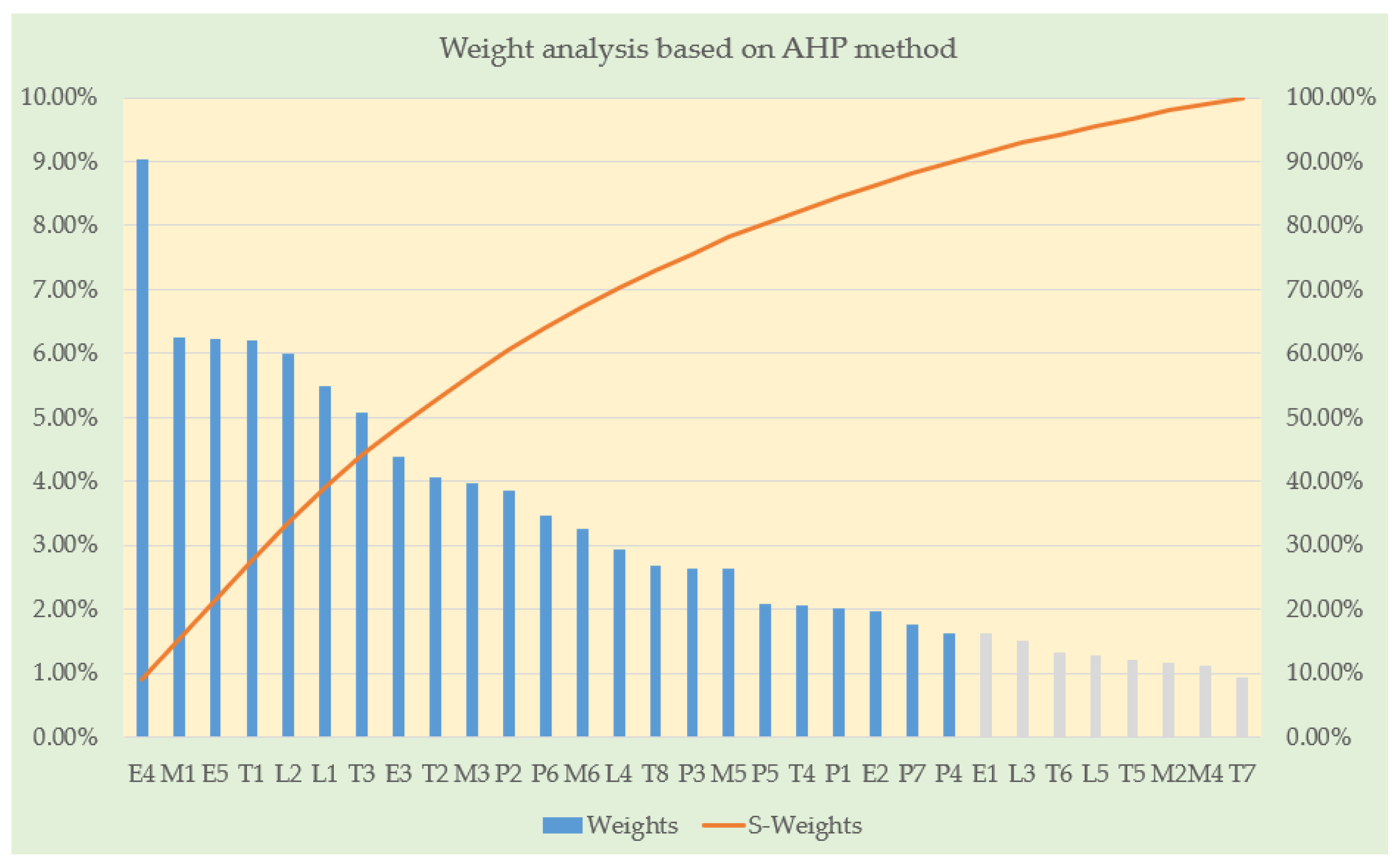
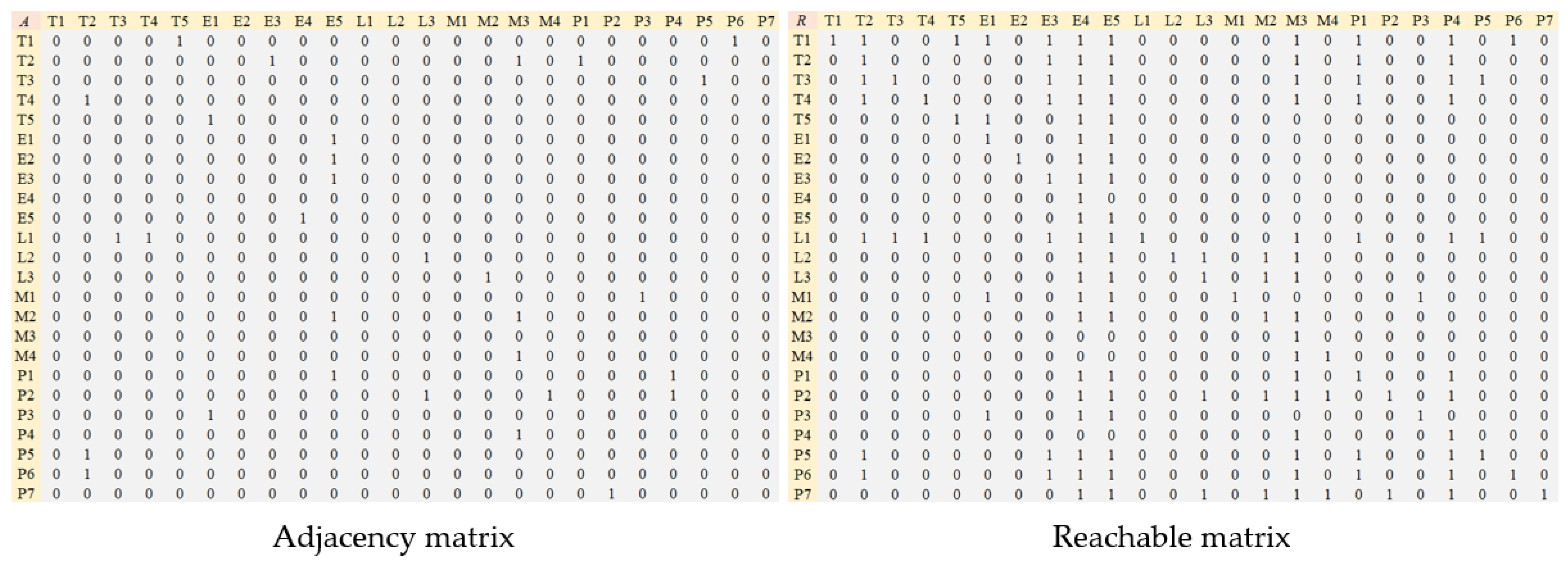
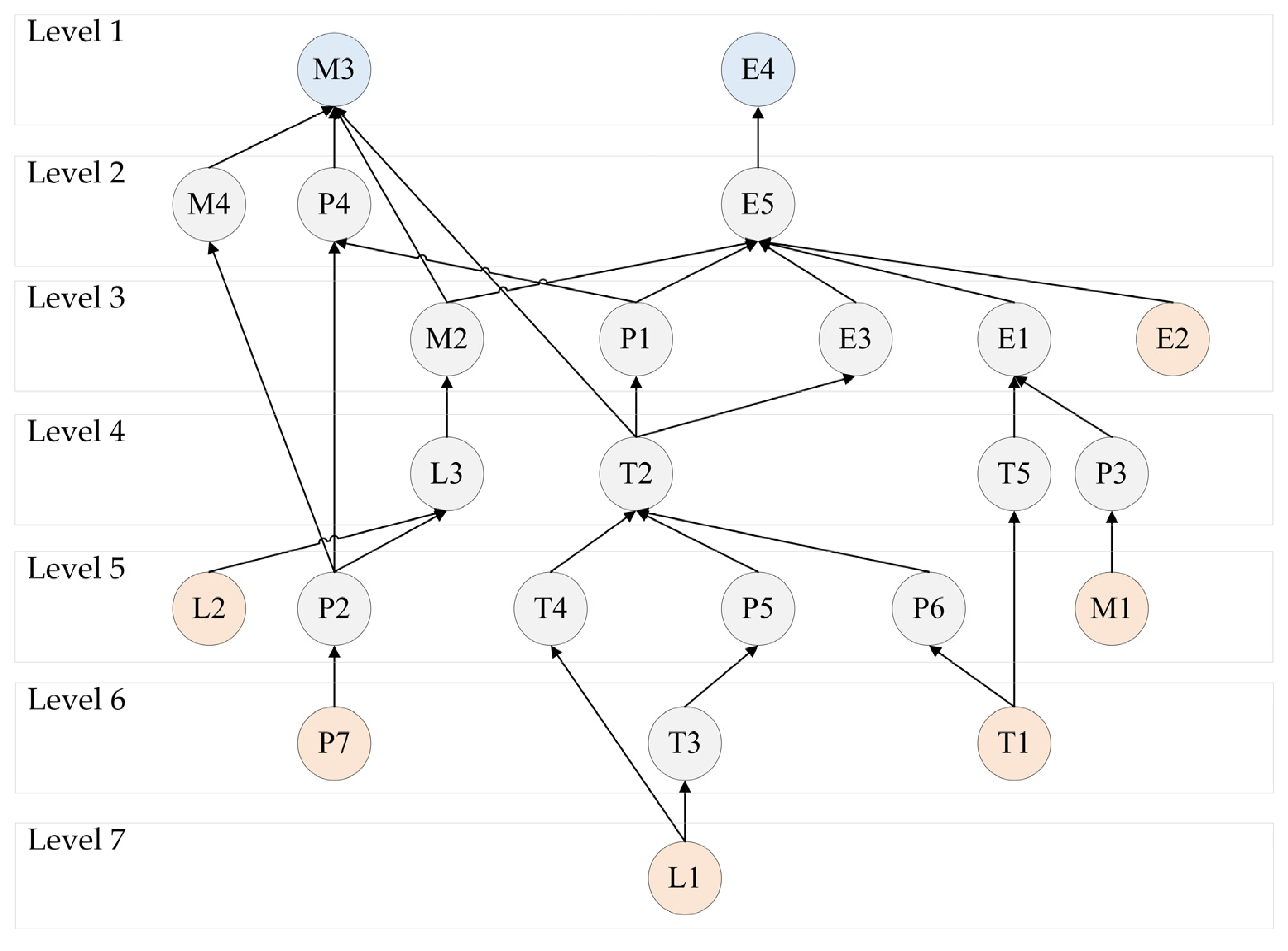
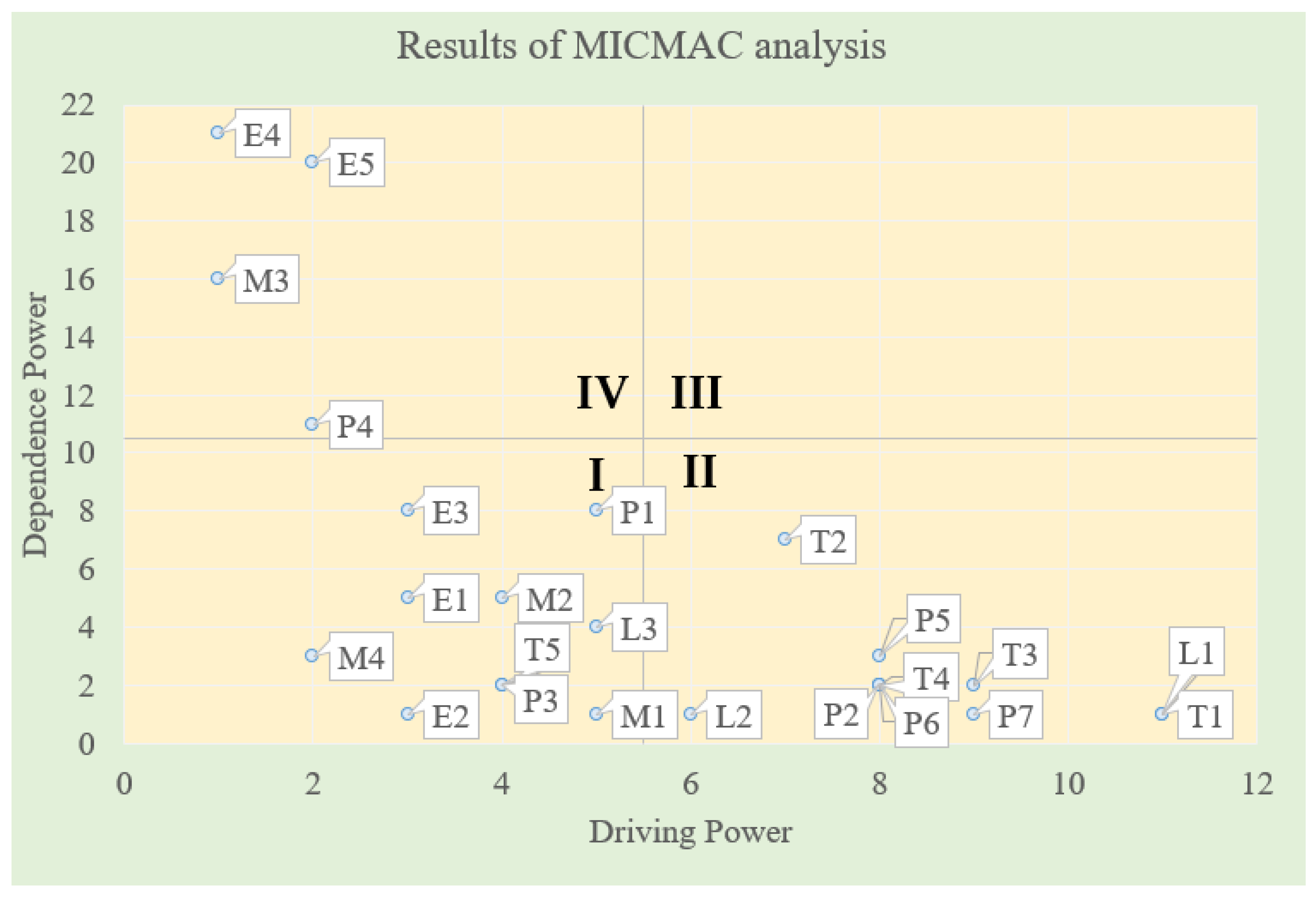
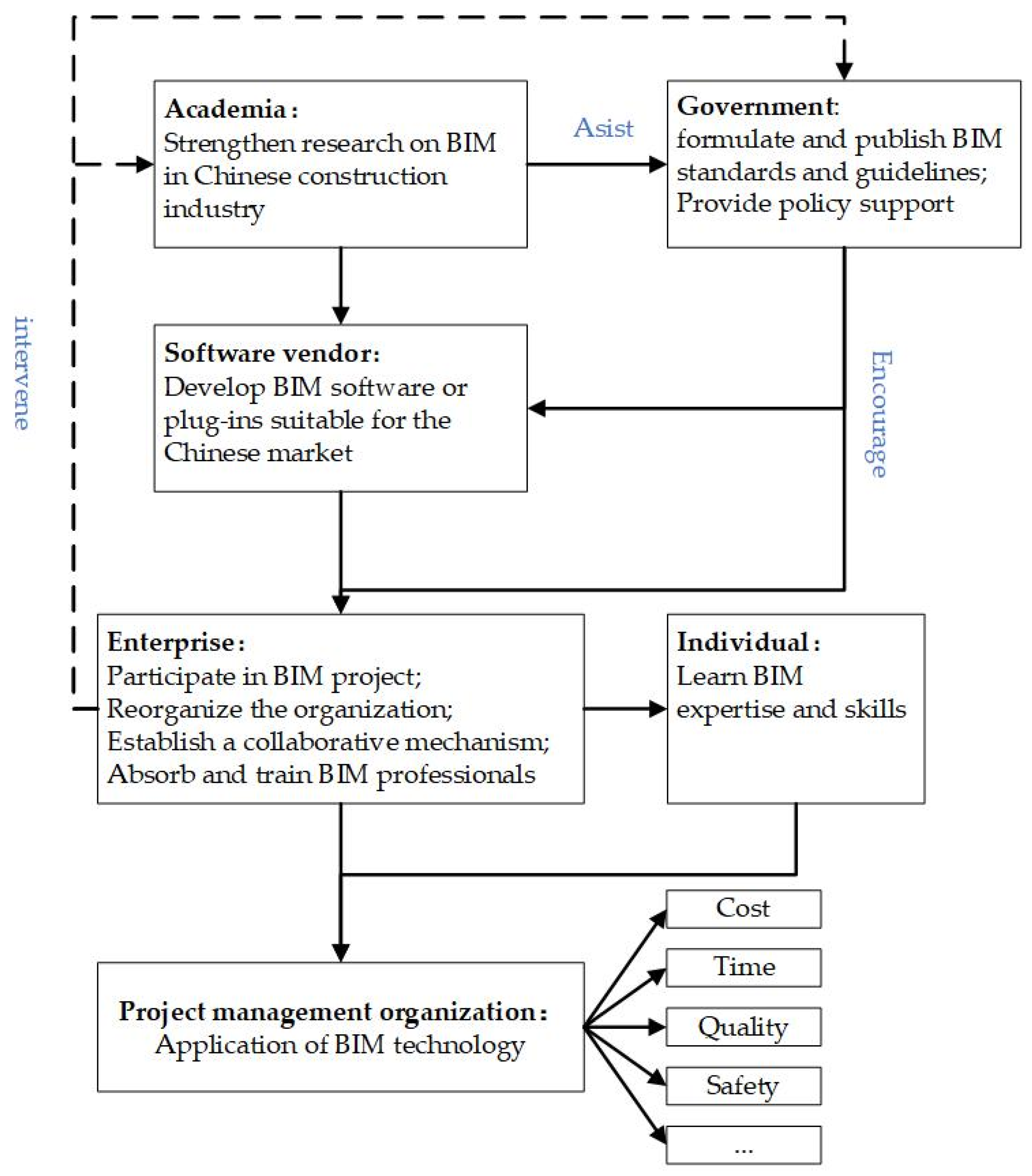
| Category | Code | Risk Factors | References |
|---|---|---|---|
| Technology | T1 | Lack of software function | [19,23,25,26,28,29] |
| T2 | Model management difficulties | [19,26,28,29] | |
| T3 | Poor software interaction | [19,23,25,26,28,29,38] | |
| T4 | Low data quality | [19,23,26,28,29] | |
| T5 | Data security issues | [19,25,26,28,29,40] | |
| T6 | Difficulties in synchronizing data | [25,26,28,29,33,40] | |
| T7 | Difficulty in modeling some structures | [25,26,28] | |
| T8 | Complexity of BIM software operations | [22,23,26,29] | |
| Economic | E1 | Staff training and recruitment costs | [19,23,26,29] |
| E2 | Infrastructure preparation of the BIM application | [22,23,28,29] | |
| E3 | Increased cost of design and maintenance | [22,23,26,28,29] | |
| E4 | Uncertainty in return on investment | [22,23,26,29] | |
| E5 | High process investment | [19,23,26,28,29,38] | |
| Law | L1 | Inadequate BIM standards and protocols | [19,23,27,29,31,34,37,38] |
| L2 | Inadequate BIM-related laws and regulations | [25,26,27,28,31,34,37,38] | |
| L3 | Unclear BIM data ownership | [23,25,26,27,29,37] | |
| L4 | Inapplicability of the contracts | [23,25,27,29,31,34,37] | |
| L5 | Lack of industry insurance | [23,26,28,29,34] | |
| management | M1 | Lack of BIM practice experience | [19,23,25,26,29,33,38] |
| M2 | Lack of support from top managers | [23,25,26,29,33] | |
| M3 | Unclear division of responsibilities | [19,23,25,29] | |
| M4 | Inconsistent cognition from project stakeholders about BIM | [23,26,28,29] | |
| M5 | Synergy dilemma | [19,23,26,29,33] | |
| M6 | Suitability of organizational structures | [26,28,29,31] | |
| application process | P1 | Increase in workload | [23,25,29] |
| P2 | Issues of Business Process Change | [23,25,28,29] | |
| P3 | Lack of professional and technical personnel | [23,26,29,38] | |
| P4 | Resistance from technicians | [23,25,28,29,31,40] | |
| P5 | Lack of model sharing | [19,23,29] | |
| P6 | Incomplete application of BIM Technology | [23,26,28] | |
| P7 | Changes in delivery mode | [23,26,28,31] |
| Definition | Scale Value |
|---|---|
| Factor i is more important than factor j by degree n | n |
| Two factors are equally important | 1 |
| Factor i is less important than j by degree 1/n | 1/n |
| Order of a Matrix | 3 | 4 | 5 | 6 | 7 | 8 | 9 |
|---|---|---|---|---|---|---|---|
| RI | 0.58 | 0.90 | 1.12 | 1.24 | 1.32 | 1.41 | 1.45 |
| Characteristic | Variable | Number | Percentage (%) |
|---|---|---|---|
| Educational Background | Bachelor’s Degree and Lower | 18 | 45.00% |
| Master Degree | 13 | 32.50% | |
| Doctoral Degree and Higher | 9 | 22.50% | |
| Work Content | Government department | 3 | 7.50% |
| University | 4 | 10.00% | |
| Research institution | 4 | 10.00% | |
| Investment unit | 6 | 15.00% | |
| Design unit | 6 | 15.00% | |
| Construction unit | 6 | 15.00% | |
| BIM consulting unit | 7 | 17.50% | |
| Software development unit | 4 | 10.00% | |
| BIM Experience | <1years | 2 | 5.00% |
| 1–3 years | 13 | 32.50% | |
| 3–5 years | 18 | 45.00% | |
| >5 years | 7 | 17.50% |
| Caterories | Technology | Economic | Law | Management | Process | Weight |
|---|---|---|---|---|---|---|
| Technology | 1.0000 | 1.3333 | 1.3333 | 1.3333 | 1.0000 | 0.2359 |
| Economic | 0.7500 | 1.0000 | 1.3333 | 1.6667 | 1.3333 | 0.2326 |
| Law | 0.7500 | 0.7500 | 1.0000 | 0.8333 | 1.1111 | 0.1723 |
| Management | 0.7500 | 0.6000 | 1.2000 | 1.0000 | 1.2778 | 0.1843 |
| Process | 1.0000 | 0.7500 | 0.9000 | 0.7826 | 1.0000 | 0.1749 |
| λmax = 5.0622, CI = 0.0156, CR = 0.0139 ≤ 0.1 | ||||||
| Criterion Layer | Weight | Indicator Layer | Relative Weight | Actual Weight |
|---|---|---|---|---|
| Technology | 23.59% | Lack of software function | 26.30% | 6.20% |
| Model management difficulties | 17.23% | 4.06% | ||
| Poor software interaction | 21.55% | 5.08% | ||
| Low data quality | 8.75% | 2.06% | ||
| Data security issues | 5.18% | 1.22% | ||
| Difficulties in synchronizing data | 5.63% | 1.33% | ||
| Difficulty in modeling some structures | 3.99% | 0.94% | ||
| Complexity of BIM software operations | 11.37% | 2.68% | ||
| Economic | 23.26% | Staff training and recruitment costs | 6.99% | 1.63% |
| Infrastructure preparation of the BIM application | 8.51% | 1.98% | ||
| Increased cost of design and maintenance | 18.82% | 4.38% | ||
| Uncertainty in return on investment | 38.88% | 9.04% | ||
| High process investment | 26.81% | 6.24% | ||
| Law | 17.23% | Inadequate BIM standards and protocols | 31.94% | 5.50% |
| Inadequate BIM-related laws and regulations | 34.79% | 5.99% | ||
| Unclear BIM data ownership | 8.73% | 1.50% | ||
| Inapplicability of the contracts | 17.02% | 2.93% | ||
| Lack of industry insurance | 7.52% | 1.30% | ||
| Management | 18.43% | Lack of BIM practice experience | 33.87% | 6.24% |
| Lack of support from top managers | 6.37% | 1.17% | ||
| Unclear division of responsibilities | 21.63% | 3.99% | ||
| Inconsistent cognition from project stakeholders about BIM | 6.07% | 1.12% | ||
| Synergy dilemma | 14.30% | 2.63% | ||
| Suitability of organizational structures | 17.76% | 3.27% | ||
| Process | 17.49% | Increase in workload | 11.57% | 2.02% |
| Issues of Business Process Change | 22.05% | 3.86% | ||
| Lack of professional and technical personnel | 15.10% | 2.64% | ||
| Resistance from technicians | 9.30% | 1.63% | ||
| Lack of model sharing | 11.99% | 2.10% | ||
| Incomplete application of BIM Technology | 19.86% | 3.47% | ||
| Changes in delivery mode | 10.14% | 1.77% |
| Category | Code | Risk Factors |
|---|---|---|
| Technology | T1 | Lack of software function |
| T2 | Model management difficulties | |
| T3 | Poor software interaction | |
| T4 | Low data quality | |
| T5 | Complexity of BIM software operations | |
| Finance | E1 | Staff training and recruitment costs |
| E2 | Infrastructure preparation of the BIM application | |
| E3 | Increased cost of design and maintenance | |
| E4 | Uncertainty in return on investment | |
| E5 | High process investment | |
| Law | L1 | Inadequate BIM standards and protocols |
| L2 | Inadequate BIM-related laws and regulations | |
| L3 | Inapplicability of the contracts | |
| management | M1 | Lack of BIM practice experience |
| M2 | Unclear division of responsibilities | |
| M3 | Synergy dilemma | |
| M4 | Suitability of organizational structures | |
| application process | P1 | increase in workload |
| P2 | Issues Of Business Process Change | |
| P3 | Lack of professional and technical personnel | |
| P4 | Resistance from technicians | |
| P5 | Lack of model sharing | |
| P6 | Incomplete application of BIM Technology | |
| P7 | Changes in delivery mode |
| Factors | Reachable Set | Antecedent Set | Common Set | Level |
|---|---|---|---|---|
| T1 | E1, E3, E4, E5, M3, P1, P4, P6, T1, T2, T5 | T1 | T1 | 6 |
| T2 | E3, E4, E5, M3, P1, P4, T2 | L1, P5, P6, T1, T2, T3, T4 | T2 | 4 |
| T3 | E3, E4, E5, M3, P1, P4, P5, T2, T3 | L1, T3 | T3 | 6 |
| T4 | E3, E4, E5, M3, P1, P4, T2, T4 | L1, T4 | T4 | 5 |
| T5 | E1, E4, E5, T5 | T1, T5 | T5 | 4 |
| E1 | E1, E4, E5 | E1, M1, P3, T1, T5 | E1 | 3 |
| E2 | E2, E4, E5 | E2 | E2 | 3 |
| E3 | E3, E4, E5 | E3, L1, P5, P6, T1, T2, T3, T4 | E3 | 3 |
| E4 | E4 | E1, E2, E3, E4, E5, L1, L2, L3, M1, M2, P1, P2, P3, P5, P6, P7, T1, T2, T3, T4, T5 | E4 | 1 |
| E5 | E4, E5 | E1, E2, E3, E5, L1, L2, L3, M1, M2, P1, P2, P3, P5, P6, P7, T1, T2, T3, T4, T5 | E5 | 2 |
| L1 | E3, E4, E5, L1, M3, P1, P4, P5, T2, T3, T4 | L1 | L1 | 7 |
| L2 | E4, E5, L2, L3, M2, M3 | L2 | L2 | 5 |
| L3 | E4, E5, L3, M2, M3 | L2, L3, P2, P7 | L3 | 4 |
| M1 | E1, E4, E5, M1, P3 | M1 | M1 | 5 |
| M2 | E4, E5, M2, M3 | L2, L3, M2, P2, P7 | M2 | 3 |
| M3 | M3 | L1, L2, L3, M2, M3, M4, P1, P2, P4, P5, P6, P7, T1, T2, T3, T4 | M3 | 1 |
| M4 | M3, M4 | M4, P2, P7 | M4 | 2 |
| P1 | E4, E5, M3, P1, P4 | L1, P1, P5, P6, T1, T2, T3, T4 | P1 | 3 |
| P2 | E4, E5, L3, M2, M3, M4, P2, P4 | P2, P7 | P2 | 5 |
| P3 | E1, E4, E5, P3 | M1, P3 | P3 | 4 |
| P4 | M3, P4 | T1, T2, T3, T4, L1, P1, P2, P4, P5, P6, P7 | P4 | 2 |
| P5 | E3, E4, E5, M3, P1, P4, P5, T2 | T3, L1, P5 | P5 | 5 |
| P6 | E3, E4, E5, M3, P1, P4, P6, T2 | T1, P6 | P6 | 5 |
| P7 | E4, E5, L3, M2, M3, M4, P2, P4, P7 | P7 | P7 | 6 |
| Factors | Driving Power | Dependence Power |
|---|---|---|
| T1 | 11 | 1 |
| T2 | 7 | 7 |
| T3 | 9 | 2 |
| T4 | 8 | 2 |
| T5 | 4 | 2 |
| E1 | 3 | 5 |
| E2 | 3 | 1 |
| E3 | 3 | 8 |
| E4 | 1 | 21 |
| E5 | 2 | 20 |
| L1 | 11 | 1 |
| L2 | 6 | 1 |
| L3 | 5 | 4 |
| M1 | 5 | 1 |
| M2 | 4 | 5 |
| M3 | 1 | 16 |
| M4 | 2 | 3 |
| P1 | 5 | 8 |
| P2 | 8 | 2 |
| P3 | 4 | 2 |
Disclaimer/Publisher’s Note: The statements, opinions and data contained in all publications are solely those of the individual author(s) and contributor(s) and not of MDPI and/or the editor(s). MDPI and/or the editor(s) disclaim responsibility for any injury to people or property resulting from any ideas, methods, instructions or products referred to in the content. |
© 2025 by the authors. Licensee MDPI, Basel, Switzerland. This article is an open access article distributed under the terms and conditions of the Creative Commons Attribution (CC BY) license (https://creativecommons.org/licenses/by/4.0/).
Share and Cite
Tang, C.; Shen, C.; Han, S.; Zhang, Y.; Gan, Y. Research on the Risk Factors and Promotion Strategies of BIM Application in China. Buildings 2025, 15, 2421. https://doi.org/10.3390/buildings15142421
Tang C, Shen C, Han S, Zhang Y, Gan Y. Research on the Risk Factors and Promotion Strategies of BIM Application in China. Buildings. 2025; 15(14):2421. https://doi.org/10.3390/buildings15142421
Chicago/Turabian StyleTang, Chao, Chuxiong Shen, Shuai Han, Yufeng Zhang, and Yuchen Gan. 2025. "Research on the Risk Factors and Promotion Strategies of BIM Application in China" Buildings 15, no. 14: 2421. https://doi.org/10.3390/buildings15142421
APA StyleTang, C., Shen, C., Han, S., Zhang, Y., & Gan, Y. (2025). Research on the Risk Factors and Promotion Strategies of BIM Application in China. Buildings, 15(14), 2421. https://doi.org/10.3390/buildings15142421








